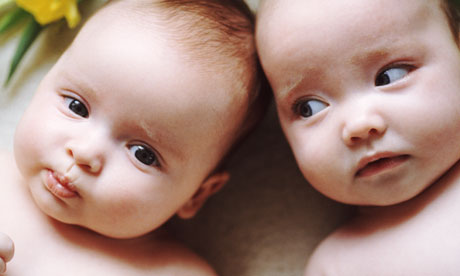
Twin and triplet babies are five times more likely to die within their first year of life than single babies, the latest data from the Office for National Statistics shows.
The infant mortality rate for multiple births in England and Wales was 20.4 per 1,000 live births in 2009, the latest year for which the ONS has analysed and published figures, while for single babies it was four per 1,000. Twins had a death rate of 20.1 per 1,000 live births before the age of one. In triplet births, which are far less common, the rate rose to 34.9 per 1,000, which is more than eight times the death rate among single infants.
The high death rates in multiple births – and complications in some of those who survive – have become a major concern as twin and triplet pregnancies steadily increased over the last decade as fertility treatment became more common, especially for older women. Nearly two-thirds (63%) of all multiple births in 2009 were to women over the age of 30. IVF clinics often put more than one embryo into the womb after egg fertilisation in the lab in order to increase the chances of success.
The Human Fertilisation and Embryology Authority (HFEA), which regulates treatment, set a target for clinics of no more than 24% multiple births in 2009, following evidence that single embryo transfer was generally as successful as putting back multiple embryos. That target has gradually reduced in an attempt to reach a ceiling of 10% multiple births from any IVF clinic, but it has not yet been attained.
A consensus statement signed by the HFEA and fertility organisations in 2011 said more work was needed to get the multiple birth rate down, but pointed out that the failure of many NHS primary care trusts to pay for sufficient fertility treatment was a factor in couples actively wanting twins so they would not have to pay thousands of pounds privately to have a second IVF baby.
"There is irrefutable evidence to show a link between the practice of transferring multiple embryos and a significantly greater risk of health complications to both mother and child," said the statement. "Multiple births can also cause distress for the parents and family and have an unsustainable immediate and long-term financial cost for society."
Multiple pregnancies rarely run to term, so the babies often have low birth weight, are underdeveloped and need intensive care to survive.
Women under the age of 20 had the highest chance of giving birth to a baby that did not survive in 2009, according to the ONS. The mortality rate among their single babies was six per 1,000 live births, which rose to 41 per 1,000 in a multiple pregnancy. "The age at which women have children has been shown to be related to their socioeconomic status," said the ONS report . "Differences in infant mortality rates by socioeconomic group persist in England and Wales, where a pattern of increased mortality among births to more socially disadvantaged mothers has also been observed."

